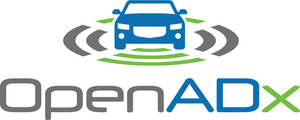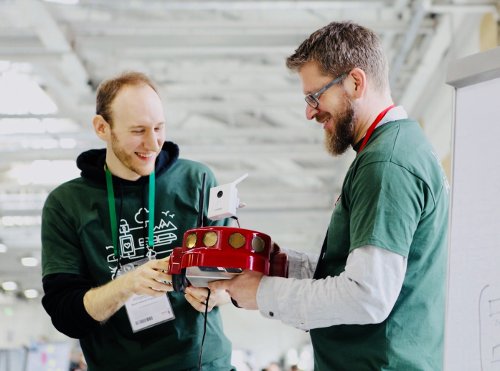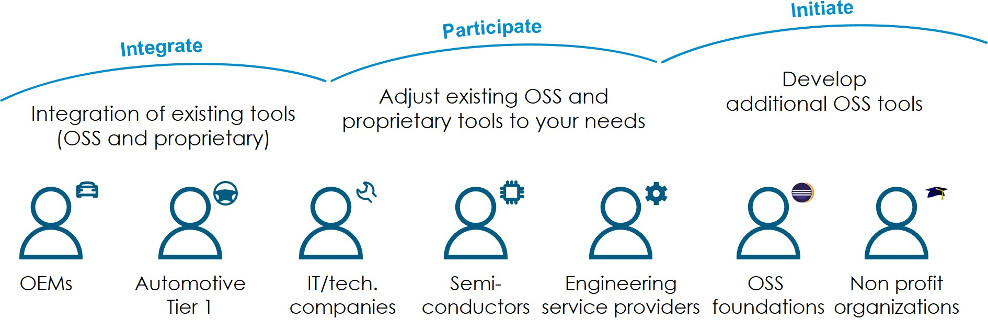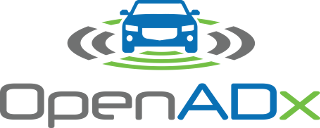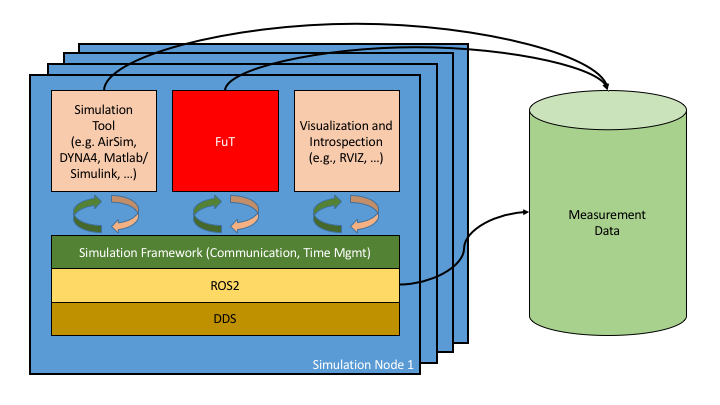Notice: This Wiki is now read only and edits are no longer possible. Please see: https://gitlab.eclipse.org/eclipsefdn/helpdesk/-/wikis/Wiki-shutdown-plan for the plan.
Difference between revisions of "AICE OpenLab WG"
(→Presentation list - Automotive@Eclipse Community Day) |
(→Participants) |
||
| Line 25: | Line 25: | ||
Please have a look to our latest news on our official [https://openadx.eclipse.org/news/ OpenADx web site] | Please have a look to our latest news on our official [https://openadx.eclipse.org/news/ OpenADx web site] | ||
| − | == | + | == Participants == |
{| class="wikitable sortable" | {| class="wikitable sortable" | ||
| − | ! | + | ! Organisation |
|- | |- | ||
| − | | | + | | ATB |
| − | | | + | | |
|- | |- | ||
|- | |- | ||
| − | | | + | | Castalia Solutions |
| − | | | + | | |
|- | |- | ||
|- | |- | ||
| − | | | + | | Continental |
| − | | | + | | |
|- | |- | ||
|- | |- | ||
| − | | | + | | Engineering Group |
| − | | | + | | |
|- | |- | ||
|- | |- | ||
| − | | | + | | Eurotech |
| − | | | + | | |
|- | |- | ||
|- | |- | ||
| − | | | + | | Fraunhofer FOKUS |
| − | | | + | | |
|- | |- | ||
|- | |- | ||
| − | | | + | | Huawei |
| − | | | + | | |
|- | |- | ||
|- | |- | ||
| − | | | + | | Itemis |
| − | | | + | | |
|- | |- | ||
|- | |- | ||
| − | | | + | | Kairos |
| − | | | + | | |
|- | |- | ||
|- | |- | ||
| − | | | + | | Konduit |
| − | | | + | | |
|- | |- | ||
|- | |- | ||
| − | | | + | | OpenADx |
| − | | | + | | |
|- | |- | ||
|- | |- | ||
| − | | | + | | Ortelio |
| − | | | + | | |
|- | |- | ||
|- | |- | ||
| − | | | + | | SmartClide |
| − | | | + | | |
|- | |- | ||
|- | |- | ||
| − | | University of | + | | University of Macedonia |
| − | | | + | | |
| + | |- | ||
| + | |- | ||
| + | | University of Skövde | ||
| + | | | ||
| + | |- | ||
| + | |- | ||
| + | | Warren.io | ||
| + | | | ||
| + | |- | ||
| + | |- | ||
| + | | | ||
|- | |- | ||
Revision as of 05:55, 31 March 2021
The OpenADx Working Group wants to serve in the field of software tools for the realization of autonomous driving (AD) by defining open interfacing standards for software for use in vehicle based systems and in testing environments, where the second will typically be realized by means of cloud services doing at least software builds, virtual test runs and collecting results. The name OpenADx thus stands for "Open, Autonomous Driving Accelerator". The group is formed by a multitude of parties from various parts of the world and supported by several well-known industry companies. The OpenADx Working Group is set up as a working group under the governance of the Eclipse Foundation.
Please find the home page and the news ticker of the OpenADx Working Group here (https://openadx.eclipse.org).
Contents
- 1 Welcome to AICE
Welcome to AICE
Automated Driving (AD) is clustered into three equally important technology areas:
1) Artificial Intelligence
2) Cloud
3) Edge
OpenADx is focused on the AD tool chain. The goal is to accelerate AD development through open collaboration and open source.
OpenADx' vision is to ensure transparency and make the complex AD tool landscape more easily accessible for enterprise users.
News
Please have a look to our latest news on our official OpenADx web site
Participants
| Organisation | |
|---|---|
| ATB | |
| Castalia Solutions | |
| Continental | |
| Engineering Group | |
| Eurotech | |
| Fraunhofer FOKUS | |
| Huawei | |
| Itemis | |
| Kairos | |
| Konduit | |
| OpenADx | |
| Ortelio | |
| SmartClide | |
| University of Macedonia | |
| University of Skövde | |
| Warren.io | |
Steering Committee 2020/2021
| Company | Name | Role |
|---|---|---|
| ADLINK Technology | Joe Speed | Driver Member |
| AVL List GmbH | Josko Balic | Driver Member |
| JC Information Management GmbH | Michael Hahn | Driver Member |
| Red Hat | Wolfram Richter | Driver Member |
| Robert Bosch GmbH | Andreas Riexinger (SC Chair) | Driver Member |
| Siemens AG | Robin van der Made | Driver Member |
| eteration A.S. | Naci Dai | Development Member |
| itemis | Andreas Graf | Development Member |
| Microsoft | Robert Nahm | User Member |
Steering Committee 2019/2020
| Company | Name |
|---|---|
| ADLINK Technology | Joe Speed |
| AVL List GmbH | Josko Balic |
| DENSO Corporation | Soheila Dehghanzadeh |
| EclipseSource | Philip Langer |
| eteration A.S. | Naci Dai |
| IBM | Christian Muszynski |
| itemis AG | Andreas Graf |
| JC Information Management GmbH | Michael Hahn |
| Microsoft | Robert Nahm |
| RedHat | Wolfram Richter |
| Robert Bosch GmbH | Andreas Riexinger |
| Siemens AG | Robin van der Made |
Related Projects and Project Proposals
Eclipse Cloe
Eclipse Cloe is an enhanced middleware solution for closed-loop simulations, with a focus on functional software tests on system level. Cloe is used as a development tool for interactive and scripted workstation simulations, for code debugging, and for automated tests on servers. Cloe covers a central part of the verification and validation strategy, needed by all vendors in the field of Automated Driving.
Status: Project Eclipse Cloe GitHub repository: in preparation
Eclipse iceoryx
In domains like automotive, robotics or gaming, a huge amount of data must be transferred between different parts of the system. If these parts are actually different processes on a POSIX based operating system like Linux, this huge amount of data has to be transferred via an inter-process-communication (IPC) mechanism. The mechanisms provided by the operating system, like message queues, normally require to copy the data and are subject to context switches between user and kernel space. In fact, it is often not only one but many copies of the transferred data between the sender and the receiver. If it comes to GBytes/s data exchange rates, avoiding these copies becomes a crucial factor. Eclipse iceoryx is a middleware with a zero-copy shared memory approach which is optimized for the huge data inter-process-communication.
Status: Project Eclipse iceoryx
GitHub repository: Eclipse iceoryx GitHub
Eclipse Cyclone DDS
Eclipse Eclipse Cyclone DDS is a very performant and robust open-source DDS implementation. Cyclone DDS is developed completely in the open as an Eclipse IoT project. Eclipse iceoryx is complementary and is being built into Eclipse Cyclone DDS.
Status: Project Eclipse Cyclone DDS
GitHub repository: Eclipse Cyclone DDS GitHub
OpenADx Toolchain Proposal
I started to fill the OpenADx blueprint with life and I would like to improve this proposal together with you, to get further examples / solutions and insights in the proposal. Please check what is missing. Appreciate your feedback!
Awesome Robotic Tooling
Just a bunch of powerful robotic resources and tools for professional robotic development with ROS in C++ and Python.
A bit more related to Robotics, but there are some tools, which are also used in AD development.
GitHub repository: Awesome Robotic Tooling
eCAL - enhanced communication layer
"The enhanced communication abstraction layer (eCAL) is a middleware that enables scalable, high performance interprocess communication on a single computer node or between different nodes in a computer network. The design is inspired by known Data Distribution Service for Real-Time Systems (see Data distribution service on wikipedia). The current eCAL implementation realizes a subset of such a DDS system, there is only a basic support for Quality of Service (QoS) driven data transport (best effort and reliable).
eCAL is designed for typical cloud computing scenarios where different processes exchange their I/O's using a publisher/subscriber pattern. The data exchange is based on so called topics. A topic wraps the payload that should be exchanged with additional informations like a unique name, a type and a description. A topic can be connected to more than one publisher and/or subscriber. These are the basic elements of the eCAL API."
eCAL uses Eclipse iceoryx. ;-)
GitHub repository: eCAL
Challenge
AD is a complex challenge and therefore requires a multifaceted development process incorporating a variety of software tools. The tools the industry currently uses are very good, but they don’t seamlessly work with one another. This is a result of the tools not being designed to work together. This is an industry-wide issue that slows us down in the race to AD development. By pooling resources, we can remove the “friction” between widely used tools. We can create something of use to all of us: open, compatible and accessible.
Problem and benefits for OEMs and Tier1s
User insight: "Developing automated driving functions is extremely complicated and requires the use of many complex software tools which do not work efficiently with one another. What I need is a set of tools which work with each other seamlessly so that my teams can move through the development process more quickly and efficiently."
Benefit: The automated driving tool chain allows your team to work together more efficiently with a suite of highly integrated tools by enabling seamless transfer of data and code through each step of the automated driving development process.
Problem and benefits for tool and technology providers
User insight: "Currently, tools used to create automated driving applications do not work efficiently with one another. If our tool/technology is compatible with other widely used technologies and tools, it will ease the development process for our customers and make our products even more attractive to them."
Benefit: The seamless integration of your technology in the automated driving tool chain makes it more attractive to organizations developing automated driving applications by increasing their development efficiency.
Integrated tool chain for AD system development
Leveraging the current tool landscape and tying in players from industry and academia is a must. Therefore, our approach is two-fold. First, we will fine-tune the development tool chain to the needs of our industry. We do this by integrating existing products in the market, adjusting existing tools to our needs, and developing additional tools through Open Source Software (OSS) where none today currently exist. Second, we will bring areas of expertise together in order to make the complex AD tool landscape more easily accessible for all stakeholders.
Approach
We believe an initiative like this should be inclusive, not exclusive. It’s about removing barriers to efficient development with widely established tools. It’s about bundling industry competencies and sharing development. We plan to demonstrate our ability to work together on joint testbeds in an open source setting. This allows potential partners to engage with a limited initial investment. The testbeds produce demonstrable results and strengthen confidence in the approach.
The Idea of Testbeds
Testbeds are setup to produce demonstrable results that incubate potential open source projects. To realize a testbed the idea is to prepare a use case/topic in a series of workshops and to execute so called Hack-Fests which assemble developers from the cooperation partners for a defined period of time, e.g. 3-4 days, in which they realize a demonstrator or prototype.
To identify testbed candidates, everybody is invited to propose ideas here to build a starting point for development of the idea towards the requirements for the execution of a Hack-Fest and for winning further interested parties.
To execute a Hack-Fest, we have identified these minimum requirements to make this a fruitful event:
- A minimum of two partners collaborating on the testbed, be it companies, universities or research organizations
- A minimum of 5 committed participants
Workflow for testbed candidates
- Verbalization of a task in use case form, which has potential for further work
- Contribution of the use cases by interested partners as testbed candidates
- Preparation of the testbed candidates in one or a series of workshops to a state that is sufficient for the participants of a HackFest to produce results
- Execution of the Hack-Fest
- Evaluation of the Hack-Fest results to decide on whether to follow the idea or to stop the effort
- Reworking the Hack-Fest results to build a contribution either to an existing project or as an initial contribution of a new open source project
Who We Are and How to Join
As we have a public website it would be nice to give newcomers an understanding who is involved and how to interact with us.
How to participate in OpenADx?
OpenADx is still in an early stage, means, since 25th June 2019 we are an official Eclipse Working Group which consists of more than 10 member companies, who are shaping the Working Group, which is done in the Steering Committee. We are currently in the “Incubation Phase” where we define the future proceeding of the working group.
OpenADx is an open working group so everyone can participate!
Feel free to use our mailing list to start a discussion or to be part of one, to get answers to your questions around OpenADx and of course to stay tuned! You can use the solutions we provide in compliance with the open source license of the specific product.
From time to time, there will be also some workshops, which will be announced via our website, wiki and mailing list. So feel free to participate!
If you would like to engage more, e.g. to shape the working group together with us, you have to fulfil some prerequisites:
- You / your company has to be at least an Eclipse Solution Member
- You / your company has to sign the OpenADx Working Group Participation Agreement and to decide your current membership level (explained in the Working Group Charter)
Our recommendation is “Participant Member” for the incubation phase and “Driver Member” after the incubation phase to have the biggest possible influence in the working group.
For further questions, you can use our mailing list. ;-)
Interested Parties
Please add the name of your organization if you are interested in OpenADx or tell us to do it for you.
- ADLINK Technology
- AITAD
- AVL
- Bosch
- CEA
- Continental (ITS)
- Dassault Systemes (3DS)
- DENSO
- EclipseSource
- Elektrobit
- Eteration
- Fachhochschule Dortmund
- German Aerospace Center (DLR)
- IBM
- IPG Automotive GmbH
- itemis
- JC Information Management GmbH
- Kontrol GmbH
- Maeve Automation
- MathWorks
- Microsoft
- Open Robotics
- Red Hat
- Renesas
- Samsung
- science + computing ag (s+c)
- Seagate CORTX
- Siemens
- TESIS DYNAware GmbH
- Vattenfall AB
- ZF Friedrichshafen AG
Communication
- We have a mailing list: Subscribe for news and discussions: Mailing list
- We have workshops with introduction sessions and have just started to work on concrete testbeds to identify topics that we agree to collaborate on. Currently these workshops are weekly telecons. Please check the mailing list for invitations or ask questions regarding content or participation
Presentations
- FOSDEM 2018 - Community Main Track: OpenADx – xcelerate your Automated Driving development
- TNG Big Tech Day: OpenADx – xcelerate your Automated Driving development – Slides: File:2018 05 18 OpenADxAtTNGBigTechDay.pdf
- Microsoft Automotive Summit - 5th June 2018: OpenADx – xcelerate your Automated Driving development
- EclipseCon Europe 2018 - 23 - 25 October 2018, Ludwigsburg, Germany:
- International Conference "Future of Automotive Software" - 10 & 11 December 2018, Holiday Inn Munich Westpark, Germany: OpenADx – xcelerate your Automated Driving development
- IBM - 2nd Developer UnConference - Rewire Industrial Business 28th Feb. 2019
Upcoming Presentations
- see also OpenADx events
Press releases
- Renesas published in Elektronik automotive: Vorteile von Open Source fuer ADAS und autonomes Fahren (only in German available)
Blog posts
- Blog Post: Autonomous Driving Toolchain
- Blog Post: Autonomous Driving Accelerator OpenADx launched
- Blog Post: 5 things you should know about OpenADx
- Blog Post: OpenADx reaches next level
OpenADx logo
Our logo design contest is finished, please find here the winning design.
Copyright Eclipse Foundation
Testbed Candidates
Candidate 1: Simulation
Challenge
The challenge in the simulation of AD functions is the big amount of test cases which can be easily generated by variation of parameters. This big amount of test cases should be handled with parallel execution of test case in multiple instances of the simulation environment.
Use Case Step 1
Target for step 1 of the testbed is the easy integration of simulation tools and function under test allowing to feed a test scenario into the simulation and to get out data for further analysis and visualization.
Acceptance Criteria:
- The simulation can easily be set up, necessary functionality for integrating and coordinating the different components of the simulation is available.
- Sinks for simulation data out of the single components but also out of the communication between the components can be attached and the data can be logged and processed during the simulation.
- The framework allows to integrate multiple simulation tools and offers a standard communication mechanism. New tools can be integrated by providing a connector between the communication mechanism and the tool.
- The simulation execution setup is prepared for containerization in order to support easy setup and execution in parallel on a scalable hardware platform without extensive installation and maintenance efforts.
Goal for Step 1: Create demonstrators that combine a simple function under test provided by Bosch and the different simulation tools which come with a relevant plant model. For scenarios to demonstrate it is planned to look into Pegasus with the potential addition of a traffic simulated by Eclipse Sumo. The scenario should be based on a closed-loop simulation that uses a model of identified objects as input for the control algorithm.
Base Architecture Step 1
The following picture shows the basic idea for the realization of step 1.
The base decision is to use DDS as the central messaging service between the simulation components. The DDS component has to be chosen in a ROS2 compatible way in order to use the ROS2 mechanisms for data access. DDS/ROS2 compliant components are connected directly to the DDS layer, whereas simulation components not compatible with DDS are attached using a dedicated connector between the component and the DDS-API.
The Simulation Framework is basically a conglomeration of support functionality which builds the glue between the participating components. It offers functionality like the above mentioned connectors, but also time management and other functionality needed to smoothly run the simulation. This component is the main target for the testbeds step 1, since it contains the stuff needed but not provided by existing tools.
On top of these base functionalities, there are simulation tools and the function under test which build the core of the simulation, i.e., the representation of the environment and the control algorithms which observe or even act in this environment. Both provide information on the simulation state in addition to ROS2 means which record the communication between the components.
All recorded data is stored in defined measurement data formats that are stored for further processing. This is represented by the Measurement Data component in the picture which is basically an interface to testbed candidate 2, resp., storing and further processing the recorded data in offline analysis.
For online analysis, tools for visualization or introspection can connect to the DDS communication in the same fashion as the simulation components. This connection allows to control the simulation, e.g., for debugging purposes. The mechanisms rely on the possibilities of ROS2 for interacting with the simulation components.
Tools under investigation concerning usage in the demonstrator currently are:
- DDS - implementation (tbd)
- ROS2/RVIZ
- Matlab/Simulink
- DYNA4
- AirSim
- Gazebo
- Dymola (Modelica) ?
Topics for Step 2
Step 1 creates a simulation environment, that can run "out-of-the-box" with simple configuration. A logical step is to embed this stuff in a management framework that allows to manage scenarios and test cases and on the other hand side supports in gathering the results and evaluate the outcome whether important test criteria have been met or whether test cases have failed while doing that on a large scale in a parallel fashion.
Glossary
Relevant technologies for this testbed are
- Eclipse SUMO (Simulation of Urban Mobility) - http://www.dlr.de/ts/de/desktopdefault.aspx/tabid-9883/16931_read-41
- OpenPASS - https://projects.eclipse.org/proposals/simopenpass
- OpenMDM - https://www.openmdm.org
- OpenDrive - http://www.opendrive.org
- OpenScenario - http://www.openscenario.org
- OpenCRG - http://www.opencrg.org
- Open Simulation Interface - https://github.com/OpenSimulationInterface/open-simulation-interface/wiki
- AirSim - https://www.microsoft.com/en-us/research/project/aerial-informatics-robotics-platform
- Autonomous Driving Cookbook - https://github.com/Microsoft/AutonomousDrivingCookbook
- ROS - http://www.ros.org
- Gazebo - http://wiki.ros.org/gazebo
- Pegasus - http://www.pegasus-projekt.info/en/home
- Proprietary Tools
Candidate 2: Massive data ingest and management
Challenge
Developing and validating AD functions requires the collection of data from various sensors, actuators and other sources. This ideally takes place in a fleet operation. However, due to the required scale and diversity of measurement systems, the AD community faces a massive amount of complex and heterogeneous data.
Descriptions / Goal
This Challenge, i.e. AD data, fulfills all aspects of 'Big Data'. It is of massive volume, there exists a large variety, it is recorded in a high velocity, and usually exists in various formats. However, most available, automotive systems for handling data captured in such an environment cannot process this data in an efficient workflow. Additionally, there exists a painful gap between measurement system and tools, and data analytics and processing platforms.
To solve this challenge, there is the need for a common and open-source handling of measurement data. This should ideally be in the form of common ETL processes, which fill the gap between the heterogeneous measurement data and a suitable backend that already as an industry standard for data analysis.
This solution should incorporate the various formats such as ADTFs .dat, ROS .bag, Vectors .mdf, ...
Suggested work packages
Work package 1 - Problem space
Understand all necessary aspects to clearly define a common problem space. The above the description of the challenge may only cover some parts and is only in the perspective of one stakeholder.
Work package 2 - ETL
Start a sample ETL implementation that provides an efficient ingest of ROS .bag files into a Hadoop environment.
Work package 3 - Data management
Evaluated what is needed to manage this massive, heterogeneous and globally distributed data.
Events
Meeting Minutes
Link to the Meeting Minutes
Assets
Pitch deck to be used inside of respective organizations File:AICEInformationDeck.zip

